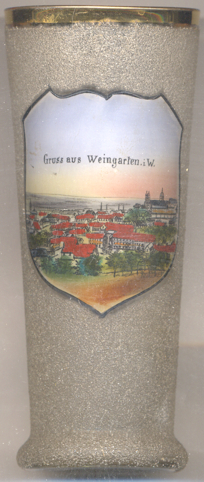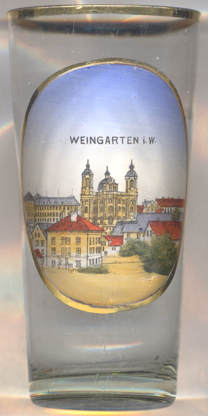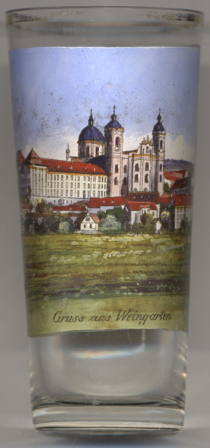

|
| DEUTSCHLAND | GERMANY |
| Bundesland: Baden-Württemberg | |
| Regierungsbezirk: Tübingen | |
| Landkreis: Ravensburg |
 Weingarten (until 1865: Altdorf) is situated at an elevation of 485 m just north of Ravensburg
in the Schussen valley in the southeast of Baden-Württemberg. The old town, the former village of Altdorf, is situated
in the valley of the Scherzach stream, which flows into the Schussen. The Weingarten monastery is located on the Martinsberg
to the northeast above the old town. The municipality Weingarten has a population of about 24,500 (2015). Together with the
southern neighbour cities of Ravensburg and Friedrichshafen on Lake Constance (Bodensee), it forms
one of 14 medium-sized infrastructural centres in Baden-Württemberg.
Weingarten (until 1865: Altdorf) is situated at an elevation of 485 m just north of Ravensburg
in the Schussen valley in the southeast of Baden-Württemberg. The old town, the former village of Altdorf, is situated
in the valley of the Scherzach stream, which flows into the Schussen. The Weingarten monastery is located on the Martinsberg
to the northeast above the old town. The municipality Weingarten has a population of about 24,500 (2015). Together with the
southern neighbour cities of Ravensburg and Friedrichshafen on Lake Constance (Bodensee), it forms
one of 14 medium-sized infrastructural centres in Baden-Württemberg.
 Near the old town, an Alemannic burial place was excavated in 1954–1957, dating from the 5th century. In the 8th
century the region became part of the Frankish empire. Around the 9th century the Elder Welfs became counts of the
Schussengau and established their seat in Altdorf. The Welfs founded a nuns' abbey in Altdorf around 935. When Welf IV
moved his residence to Ravensburg in 1056, he founded a new Benedictine monastery on the
Martinsberg in 1056. The monastery was settled by monks from Altomünster, in return, the Altdorf nuns settled the
monastery in Altomünster. The name of the monastery, Weingarten ('vineyard') is documented as early as
c. 1123. During the 13th century Altdorf became a market town. While the small town of Altdorf was ruled by the
Reichslandvogt (imperial steward resp. bailiff) of Swabia, the abbey of Weingarten in 1244 obtained the status of an
"Imperial Abbey" with privileges similar to those of an Imperial Free City. The abbey of Weingarten became one of the
wealthiest monasteries in southern Germany, owning about 306 km² of rich estates, before it was confiscated
during the secularisation following the Reichsdeputationshauptschluss bill in 1803. Weingarten was first allotted to the
principality of Nassau-Orange, Altdorf to the duchy of Württemberg. In 1806 Weingarten, too, was incorporated into
Württemberg (since 1806 kingdom).
During the 19th century several barracks were placed in Altdorf-Weingarten, making the city an important military site.
As in neighbouring Ravensburg, a significant engineering industry evolved during the second half of the century, based
mainly on the local traditions of (paper and other) mills and textile production. In 1865, Altdorf was renamed
Weingarten. During Nazi Germany Weingarten was incorporated into Ravensburg; after the war, the rival cities were
separated again. During the municipal reforms of the 1970s, a renewed attempt to fuse Ravensburg and Weingarten failed
due to massive resistance on the part of Weingarten's citizenry.
Near the old town, an Alemannic burial place was excavated in 1954–1957, dating from the 5th century. In the 8th
century the region became part of the Frankish empire. Around the 9th century the Elder Welfs became counts of the
Schussengau and established their seat in Altdorf. The Welfs founded a nuns' abbey in Altdorf around 935. When Welf IV
moved his residence to Ravensburg in 1056, he founded a new Benedictine monastery on the
Martinsberg in 1056. The monastery was settled by monks from Altomünster, in return, the Altdorf nuns settled the
monastery in Altomünster. The name of the monastery, Weingarten ('vineyard') is documented as early as
c. 1123. During the 13th century Altdorf became a market town. While the small town of Altdorf was ruled by the
Reichslandvogt (imperial steward resp. bailiff) of Swabia, the abbey of Weingarten in 1244 obtained the status of an
"Imperial Abbey" with privileges similar to those of an Imperial Free City. The abbey of Weingarten became one of the
wealthiest monasteries in southern Germany, owning about 306 km² of rich estates, before it was confiscated
during the secularisation following the Reichsdeputationshauptschluss bill in 1803. Weingarten was first allotted to the
principality of Nassau-Orange, Altdorf to the duchy of Württemberg. In 1806 Weingarten, too, was incorporated into
Württemberg (since 1806 kingdom).
During the 19th century several barracks were placed in Altdorf-Weingarten, making the city an important military site.
As in neighbouring Ravensburg, a significant engineering industry evolved during the second half of the century, based
mainly on the local traditions of (paper and other) mills and textile production. In 1865, Altdorf was renamed
Weingarten. During Nazi Germany Weingarten was incorporated into Ravensburg; after the war, the rival cities were
separated again. During the municipal reforms of the 1970s, a renewed attempt to fuse Ravensburg and Weingarten failed
due to massive resistance on the part of Weingarten's citizenry.
 The
The  basilica St. Martin and Oswald is the former abbey church of the Imperial
Abbey of Weingarten. The founding stone of the Baroque church was laid in 1715 to replace the former, Romanesque
church of the Benedictine monastery. The church was consecrated in 1724. With a height of 67 metres and a length
of 102 metres, it is the largest Baroque church in Germany and north of the Alps. St. Peter's basilica in
the Rome was chosen as a model, the Weingarten abbey church being approximately half of
the size of St. Peter's. Since the dissolution of the Weingarten monastery in 1803, it serves as the
parish church of the parish St. Martin. In 1922, the monastery was settled again by Benedictine monks; however
this new monastery was dissolved again in 2010. In 1956, the church received the title Basilica minor from Pope
Pius XII. The most venerated treasure of the church is the reliquiary of the Holy Blood, donated to the monastery
in 1094 by Judith of Flanders, wife of Welf IV.
basilica St. Martin and Oswald is the former abbey church of the Imperial
Abbey of Weingarten. The founding stone of the Baroque church was laid in 1715 to replace the former, Romanesque
church of the Benedictine monastery. The church was consecrated in 1724. With a height of 67 metres and a length
of 102 metres, it is the largest Baroque church in Germany and north of the Alps. St. Peter's basilica in
the Rome was chosen as a model, the Weingarten abbey church being approximately half of
the size of St. Peter's. Since the dissolution of the Weingarten monastery in 1803, it serves as the
parish church of the parish St. Martin. In 1922, the monastery was settled again by Benedictine monks; however
this new monastery was dissolved again in 2010. In 1956, the church received the title Basilica minor from Pope
Pius XII. The most venerated treasure of the church is the reliquiary of the Holy Blood, donated to the monastery
in 1094 by Judith of Flanders, wife of Welf IV.
(see also list of other basilicae minores depicted on glasses of this collection)
[https://de.wikipedia.org/wiki/Weingarten_(Württemberg), https://en.wikipedia.org/wiki/Weingarten,_Württemberg;
https://de.wikipedia.org/wiki/Basilika_St._Martin_(Weingarten)]
![[scale]](lineal.jpg)